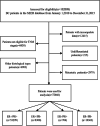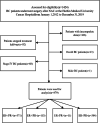Estrogen receptor-negative/progesterone receptor-positive breast cancer has distinct characteristics and pathologic complete response rate after neoadjuvant chemotherapy
- PMID: 38178166
- PMCID: PMC10765627
- DOI: 10.1186/s13000-023-01433-6
Estrogen receptor-negative/progesterone receptor-positive breast cancer has distinct characteristics and pathologic complete response rate after neoadjuvant chemotherapy
Abstract
Purpose: The status of hormone receptors (HR) is an independent factor affecting survival and chemotherapy sensitivity in breast cancer (BC) patients, with estrogen receptor (ER) and progesterone receptor (PR) having the most significant effects. The ER-/PR + phenotype has been controversial in BC, and experts will face many challenges in determining treatment strategies. Herein, we systematically analyzed the clinicopathological characteristics of the ER-/PR + phenotype in BC patients and the response to chemotherapy.
Patients and methods: We included two cohorts. The first cohort counted the relationship between clinicopathologic data and survival outcomes for 72,666 female patients in the Surveillance, Epidemiology, and End Results (SEER) database. The second cohort analyzed the relationship between clinicopathological data and pathologic complete response (pCR) rate in 879 patients at the Harbin Medical University Cancer Hospital. The classification data were compared by the chi-square test and Fister's exact test of the Logistic regression model, and predictor variables with P < 0.05 in the univariate analysis were included in the multivariate regression analysis. The Kaplan-Meier method evaluated breast cancer-specific survival (BCSS) and overall survival (OS) to investigate the relationship between different HR typing and survival and pCR.
Results: In the two cohorts, 704 (0.9%) and 11 (1.3%) patients had the ER-/PR + phenotype, respectively. The clinicopathologic features of patients with the ER-/PR + phenotype are more similar to those of the ER-/PR- phenotype. The ER-/PR + phenotype is more common in younger and premenopausal women, and most ER-/PR + phenotypes exhibit higher histological grades. Survival analysis showed that there were significant differences in OS and BCSS among patients with different HR states (P < 0.001). The survival results of patients with the ER + /PR + phenotype were the best. The prognosis of the ER-/PR + phenotype was similar to that of the ER-/PR- phenotype. On the other hand, we found that HR status was also an independent predictor of post-NAC pCR rate in BC patients. The ER + /PR- and ER-/PR- phenotypes were more sensitive to chemotherapy than the ER + /PR + phenotypes.
Conclusion: HR status is the main factor affecting BC's survival outcome and pCR rate. Patients with the ER-/PR + phenotype possess more aggressive biological factors and can benefit significantly from chemotherapy. We need to pay more attention to this group and achieve individualized treatment, which will help us treat BC better and provide new targets and blueprints for our clinical treatment.
Keywords: Breast cancer; Estrogen receptor; Neoadjuvant chemotherapy; Pathologic complete response; Progesterone receptor.
© 2023. The Author(s).
Conflict of interest statement
The authors declare no competing interests.
Figures









Similar articles
-
Real-world data on breast pathologic complete response and disease-free survival after neoadjuvant chemotherapy for hormone receptor-positive, human epidermal growth factor receptor-2-negative breast cancer: a multicenter, retrospective study in China.World J Surg Oncol. 2022 Sep 29;20(1):326. doi: 10.1186/s12957-022-02787-9. World J Surg Oncol. 2022. PMID: 36175898 Free PMC article.
-
ER+/PR- phenotype exhibits more aggressive biological features and worse outcome compared with ER+/PR+ phenotype in HER2-negative inflammatory breast cancer.Sci Rep. 2024 Jan 2;14(1):197. doi: 10.1038/s41598-023-50755-4. Sci Rep. 2024. PMID: 38167641 Free PMC article.
-
Clinicopathological Characteristics and Breast Cancer-Specific Survival of Patients With Single Hormone Receptor-Positive Breast Cancer.JAMA Netw Open. 2020 Jan 3;3(1):e1918160. doi: 10.1001/jamanetworkopen.2019.18160. JAMA Netw Open. 2020. PMID: 31899528 Free PMC article.
-
Single hormone receptor-positive breast cancer patients experienced poor survival outcomes: a systematic review and meta-analysis.Clin Transl Oncol. 2020 Apr;22(4):474-485. doi: 10.1007/s12094-019-02149-0. Epub 2019 Jun 20. Clin Transl Oncol. 2020. PMID: 31222450
-
The role of quantitative estrogen receptor status in predicting tumor response at surgery in breast cancer patients treated with neoadjuvant chemotherapy.Breast Cancer Res Treat. 2017 Jul;164(2):285-294. doi: 10.1007/s10549-017-4269-6. Epub 2017 May 2. Breast Cancer Res Treat. 2017. PMID: 28466123 Review.
Cited by
-
Higher baseline platelet and preoperative platelets to lymphocytes ratio was associated with a higher incidence of axillary node pathologic complete response after neoadjuvant chemotherapy in HER2-low breast cancer: a retrospective cohort study.Front Oncol. 2025 Mar 14;15:1437677. doi: 10.3389/fonc.2025.1437677. eCollection 2025. Front Oncol. 2025. PMID: 40161379 Free PMC article.
-
Factors influencing pathological complete response to neoadjuvant chemotherapy in resectable breast cancer: A retrospective study.Oncol Lett. 2025 May 27;30(1):366. doi: 10.3892/ol.2025.15112. eCollection 2025 Jul. Oncol Lett. 2025. PMID: 40476040 Free PMC article.
-
Prediction of neoadjuvant chemotherapy efficacy in breast cancer: integrating multimodal imaging and clinical features.BMC Med Imaging. 2025 Apr 14;25(1):118. doi: 10.1186/s12880-025-01631-2. BMC Med Imaging. 2025. PMID: 40229675 Free PMC article.
References
MeSH terms
Substances
Grants and funding
LinkOut - more resources
Full Text Sources
Medical
Research Materials

